|
On
December
14,
2009
there
were
1086
potentially
hazardous
asteroids.
Dec.
2009
Earth-asteroid
encounters:
| Asteroid |
Date(UT)
|
Miss Distance
|
Mag.
|
Size
|
| 2009 WV25 |
Dec. 1
|
2.9 LD
|
16
|
65 m
|
| 2009 WA52 |
Dec. 5
|
8.2 LD
|
20
|
23 m
|
| 2002 WP |
Dec. 6
|
71.2 LD
|
16
|
950 m
|
.
|
1-13-10- Sunspot 1040 - formerly 1035
Solar wind
speed: 438.0 km/sec
density: 7.4 protons/cm3
explanation |
more
data
Updated: Today at 0314
UT
X-ray Solar Flares
6-hr max: B1 1800
UT Jan12
24-hr: C1 1320 UT
Jan12
explanation |
more data
Updated: Today at: 2355
UT
| 1-31-10 - sunspot 1041 |
| 1-30-10 - sunspot 1041
Sunspot 1041 has almost completely
faded away. In January 2009, the sun was blank for 25 days. In January
2010, the sun has been blank only 2 days. Despite the fading of 1041,
solar activity is clearly on the rise.
Current conditions
Solar wind
speed: 383.1 km/sec
density: 6.6 protons/cm3
explanation |
more
data
Updated: Today at 1744
UT
X-ray Solar Flares
6-hr max: B1 1720
UT Jan30
24-hr: B1 1720 UT
Jan30
explanation |
more data
Updated: Today at: 1745
UT
|
1-29-10 - sunspot 1041
Current conditions
Solar wind
speed: 344.4 km/sec
density: 6.9 protons/cm3
explanation |
more data
Updated: Today
at 2345 UT
X-ray Solar Flares
6-hr max: A4
1950 UT Jan29
24-hr: A6
0035 UT Jan29
explanation |
more data
Updated: Today
at: 2340 UT
Firefly Mission to Study Terrestrial Gamma-ray
Flashes |
01.29.2010
+ Play Audio
|
+ Download Audio |
+ Email to a friend |
+ Join mailing list
January 29, 2010: High-energy
bursts of gamma rays typically occur far out
in space, perhaps near black holes or other
high-energy cosmic phenomena. So imagine
scientists' surprise in the mid-1990s when
they found these powerful gamma ray flashes
happening right here on Earth, in the skies
overhead.
 They're
called Terrestrial Gamma-ray Flashes, or TGFs,
and very little is known about them. They seem
to have a connection with lightning, but TGFs
themselves are something entirely different. They're
called Terrestrial Gamma-ray Flashes, or TGFs,
and very little is known about them. They seem
to have a connection with lightning, but TGFs
themselves are something entirely different.
Right: An artist's concept of
TGFs. Credit: NASA/Robert Kilgore [more]
"In fact," says Doug Rowland of NASA's Goddard
Space Flight Center, "before the 1990s nobody
knew they even existed. And yet they're the
most potent natural particle accelerators on
Earth."
Individual particles in a TGF acquire a huge
amount of energy, sometimes in excess of 20
mega-electron volts (MeV). In contrast, the
colorful auroras that light up the skies at
high latitudes are powered by particles with
less than one thousandth as much energy.
At this stage, there are more questions about
TGFs than answers. What causes these
high-energy flashes? Do they help trigger
lightning--or does lightning trigger them?
Could they be responsible for some of the
high-energy particles in the Van Allen
radiation belts, which can damage satellites?
To investigate, Rowland and his colleagues at
GSFC, Siena College, Universities Space
Research Association, and the Hawk Institute
for Space Sciences are planning to launch a
tiny, football-sized satellite called Firefly
in 2010 or 2011. Because of its small size,
Firefly will cost less than $1 million — about
100 times cheaper than what satellite missions
normally cost. Part of the cost savings comes
from launching Firefly under the National
Science Foundation's CubeSat program, which
launches small satellites as "stowaways"
aboard rockets carrying larger satellites into
space, rather than requiring dedicated rocket
launches.
Below: An artist's concept of
Firefly on the lookout for TGFs above a
thunderstorm. Firefly will make simultaneous
measurements of energetic electrons, gamma
rays, and the radio and optical signatures of
the lightning discharge. [more]

If successful, Firefly will return the first
simultaneous measurements of TGFs and
lightning. Most of what's known about TGFs to
date has been learned from missions meant to
observe gamma rays coming from deep space,
such as NASA's Compton Gamma Ray Observatory,
which discovered TGFs in 1994. As it stared
out into space, Compton caught fleeting
glimpses of gamma rays out of the corner of
its eye, so to speak. The powerful flashes
were coming--surprise!--from Earth's
atmosphere.
Subsequent data from Compton and other space
telescopes have provided a tantalizingly
incomplete picture of how TGFs occur:
In the skies above a thunderstorm, powerful
electric fields generated by the storm stretch
upward for many miles into the upper
atmosphere. These electric fields accelerate
free electrons, whisking them to speeds
approaching the speed of light. When these
ultra-high speed electrons collide with
molecules in the air, the collisions release
high-energy gamma rays as well as more
electrons, setting up a cascade of collisions
and perhaps more TGFs.
 Right:
Doug Rowland, principal investigator for
Firefly stands next to the a life-sized model
of the tiny satellite. Credit: NASA/Pat Izzo Right:
Doug Rowland, principal investigator for
Firefly stands next to the a life-sized model
of the tiny satellite. Credit: NASA/Pat Izzo
To the eye, a TGF probably wouldn't look like
much. Unlike lightning, most of a TGF's energy
is released as invisible gamma rays, not
visible light. They don't produce colorful
bursts of light like sprites and other
lightning-related phenomena. Nevertheless,
these unseen eruptions could help explain why
brilliant lightning strikes occur.
A longstanding mystery about lightning is how
a strike gets started. Scientists know that
the turbulence inside a thundercloud separates
electric charge, building up enormous
voltages. But the voltage needed to ionize air
and generate a spark is about 10 times greater
than the voltage typically found inside storm
clouds.
"We know how the clouds charge up," Rowland
says, "we just don't know how they discharge.
That is the mystery."
TGFs could provide that spark. By generating a
quick burst of electron flow, TGFs might help
lightning strikes get started, Rowland
suggests. "Perhaps this phenomenon is why we
have lightning," he says.
If so, there ought to be many more TGFs each
day than currently known. Observations by
Compton and other space telescopes indicate
that there may be fewer than 100 TGFs
worldwide each day. Lightning strikes millions
of times per day worldwide. That's quite a
gap.
Then again, Compton and other space telescopes
before Firefly weren't actually looking for
TGFs. So perhaps it's not surprising that they
didn't find many. Firefly will specifically
look for gamma ray flashes coming from the
atmosphere, not space, conducting the first
focused survey of TGF activity. Firefly's
sensors will even be able to detect flashes
that are mostly obscured by the intervening
air, which is a strong absorber of gamma rays
(a fact that protects people on the ground
from the energy in these flashes). Firefly's
survey will give scientists much better
estimates of the number of TGFs worldwide and
help determine if the link to lightning is
real.
Stay tuned to Science@NASA for updates.
Author: Patrick Barry |
Editor:
Dr. Tony Phillips | Credit:
Science@NASA
1-28-10 - sunspot 1041
Current conditions
Solar wind
speed: 349.0 km/sec
density: 5.3 protons/cm3
explanation |
more
data
Updated: Today at 2057
UT
X-ray Solar Flares
6-hr max: B1 2030
UT Jan28
24-hr: B2 0645 UT
Jan28
explanation |
more data
Updated: Today at: 2045
UT
BIGGEST FULL
MOON OF THE YEAR: This Friday night,
if you think the Moon looks unusually big, you're
right. It's the biggest full Moon of 2010. Astronomers
call it a "perigee Moon," some 14% wider and 30%
brighter than lesser full Moons of the year.
(continued below)
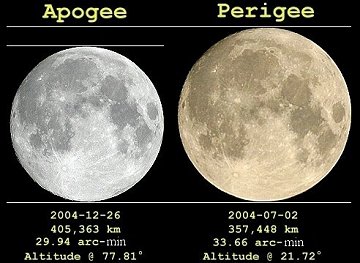
Image credit and copyright: Anthony Ayiomamitis:
details.

Johannes Kepler explained the phenomenon 400 years
ago. The Moon's orbit around Earth is not a circle; it
is an ellipse, with one side 50,000 km closer to Earth
than the other. Astronomers call the point of closest
approach "perigee," and that is where the Moon will be
Friday night:
diagram.
Look around sunset when the Moon is near the
eastern horizon. At that time, illusion mixes with
reality to produce a truly stunning view. For reasons
not fully understood by psychologists, low-hanging
Moons look unnaturally large when they beam through
foreground objects such as buildings and trees. Why
not let the "Moon illusion" amplify a full Moon that's
extra-big to begin with? The swollen orb rising in the
east may seem close enough to touch.
And what's that bright orange star right beside the
Moon? Read on...
IT'S MARS!
In a coincidence of celestial
proportions, the Moon and Mars are having
close encounters with Earth at the same time.
Moreover, the two will spend Friday night gliding
across the sky side-by-side. It's a must-see event:
sky map.
On Jan. 27th, Tamas Ladanyi of Tes, Hungary, caught
this view of the Red Planet, pre-conjunction:

"I used a
Canon 500D (ISO 1600, 6 sec) to photograph the
winter landscape on the plateau of Tes with its famous
windmills in bright moonlight," says Ladanyi. "Mars
shone beautifully above it all."
Readers with backyard telescopes should train their
optics on Mars. The planet looks bigger through a
telescope now than at any time between 2008 and 2014.
Browse the links for views through the
eyepiece:
from John Nassr of Baguio, Philippines;
from Alan Friedman of Buffalo, New York;
from Mike Hood of Kathleen, Georgia;
from John Nassr of Baguio, Philippines;
from Jacob Bassøe of Copenhegen, Denmark;
from Sadegh Ghomizadeh of Tehran, Iran;
|
| 1-27-10

http://www.youtube.com/watch?v=8POHkMQg0Dw
Image:Huge spheres by sun
From PESWiki
-
UFOs >
Earth-sized spheres in vicinity of Sun? - A YouTuber has
posted a video showing some images he pulled from NASA's website
that show several Earth-sized spheres next to the Sun. What are
they? "Nasa removed the photos. I saw the photos on their site
yesterday. Very strange!" -- aurayon (YouTube; user
critiquekat; Jan. 21, 2010)
Click on a date/time to view the file as it appeared at that
time.
| |
Date/Time |
User |
Dimensions |
File size |
Comment |
| (current) |
17:51, 27 January 2010 |
SilverThunder (Talk
|
contribs) |
95×95 |
2 KB |
UFOs
http://www.youtube.com/watch?v=8POHkMQg0Dw Earth-sized spheres in vicinity of Sun?]''' - A YouTuber has
posted a video showing some images he pulled from NASA's
website that show several Earth-sized |
Earth-sized spheres in vicinity of Sun?
January 27, 12:02 PM 
 |
A YouTuber has posted a video showing some images he
pulled from NASA's website from their recent SOHO
images that show several Earth-sized spheres near the
Sun's corona. What are they? Why are the images now
gone from NASA's website?
According to the video description, "these huge
spherical [objects] started appearing around January
18, 2010. They are on both the forward and rear images
taken by NASA's Stereo Spacecraft in space. They
appear to be moving as they are in different positions
on many photos. ...If they were planets or some type
of huge asteroid comets, they would already have been
pulled into the sun by the strong gravity the sun
produces as in the case of the recent comet."
Adding to the mystery, the
images became
inaccessible today. "Nasa removed the photos. I saw
the photos on their site yesterday. ? Very strange!"
-- aurayon
Some speculate that the images seem to be a
fulfillment of Biblical prophecy in Luke 21:5 "And
there shall be signs in the sun."
In a spirit of humor, we might speculate that perhaps
they could be solar-energy-harvesting modules by some
advanced extraterrestrial civilizations unseen (surely
with cloaking capability to hide their presence from
backward humans) -- or perhaps a breed of ET's that
need that much heat to thrive.
Matt Imber
speculates: "Maybe they are here to help and prevent
the mass coronal ejections or gravimetric energy from
being so bad during the alignment."
However, with further investigation, the mystery is
solved.
EDITORS NOTE: Remember when all UFOs were swamp gas or the
Planet Venus?
NASA spokesman, Bernhard Fleck, Ph.D., ESA and SOHO
Project Scientist, gives a much less titillating
explanation. In phone interview with Linda Moulton
Howe of
Earthfiles.com on
January 26, 2010 he said:
"Cosmic rays leave white dots or short trails in our
SOHO images all the time, even though we have
software that is supposed to help clean up the
images. Cosmic rays are high energy particles from
the solar wind, and from the galaxy as a whole, that
whip around the SOHO spacecraft and interact with
the detectors. These produce spots and streaks on
the detector ranging from a single pixel, to large
streaks that span a large fraction of the image.
These are most evident during a solar storm, but are
always present at some level. The software which
puts the images up on the web will fill in these
blocks from the last good image, and if there's a
cosmic ray in that block from the previous image, it
will appear in this image as well. The way to check
for this is to look at the raw data files, which are
also available on the web through the
SOHO catalog interface."
As I poked around, it became apparent that the
SOHO portion of the
NASA website is presently down and is likely to be
recovered soon; and these particular images have not
been targeted. No suppression going on here, just a
technical glitch -- like the spheres on the images.
It's safe to take the tin foil hats off now.
Other Coverage
Giant UFOs around the Sun? NASA claims malfunction, physicist says
giant ET UFOs use Sun’s star gate

FIG. A- NASA: Stereo solar image, Jan. 23, 2010
NASA’s Stereo spacecraft monitoring the Sun began registering huge
spherical UFO’s in the vicinity of the Sun around January 18, 2010.
According to one
observer, the UFOs “appear to be moving as they are in different
positions on many [of the NASA Stereo] photos, and are huge possibly at
least the size of Earth. If the UFOs were planets or some type of huge
asteroid comets, they would already have been pulled into the Sun by the
strong gravity the Sun produces as in the case of the recent comet."
Dr. Joe Gurman, NASA Stereo Project scientist states the giant solar
UFOs are compression artifacts. Moreover, he states, the "’central data
recorder’ at DSN, that stores all the playback data from all the
missions DSN supports, failed' on January 18, 2010, the date the solar
UFO wave began, thus accounting for the images of giant UFOs (see full
statement in the article below).
In a quantum physics solution to the mystery of the giant solar UFOs,
physicist
Nassim Haramein, whom this reporter knows, states in a video-taped
analysis (below) that Earth-sized UFOs are in fact giant
extraterrestrial or interdimensional spacecraft, which are accessing our
solar system, using the Sun as a black-hole singularity, or star gate.
Mr. Haramein contends that NASA Stereo data of giant solar UFOs prove
that extraterrestrial civilizations access our solar system via a star
gate on the Sun when using large (Earth-size) vehicle spacecraft.
Continues at:
http://www.examiner.com/examiner/x-2912-Seattle-Exopolitics-Examiner~y2010m1d27-Giant-UFOs-around-the-Sun-NASA-claims-malfunction-physicist-says-giant-ET-UFOs-use-Suns-star-gate
|
1-26-10 - sunspot 1041 and 1042
Current conditions
Solar wind
speed: 361.1 km/sec
density: 7.4 protons/cm3
explanation |
more data
Updated: Today
at 2345 UT
X-ray Solar Flares
6-hr max: B6
1750 UT Jan26
24-hr: B6
1750 UT Jan26
explanation |
more data
Updated: Today
at: 2340 UT
MINOR METEOR OUTBURST:
On the night of Jan. 20/21, an
unexpected flurry of ten meteors
emerged from the vicinity of Ursa
Minor, the Little Dipper. "They were
recorded by a network of six video
cameras operated by amateur
astronomers in Finland," report Peter
Jenniskens of the SETI Institute in
California and Esko Lyytinen of
Helsinki, Finland. "We call them
'gamma Ursae Minorids.'"This image
shows a sky map of meteor trails
recorded by the video network that
night:
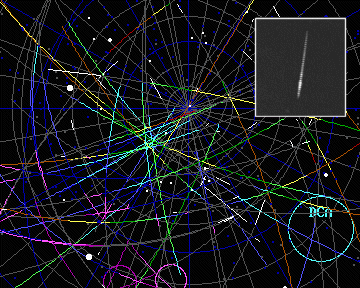
Image courtesy Esko
Lyytinen and Peter Jenniskens
The gamma Ursae
Minorids are traced in blue. "Note how
the blue lines converge near a single
radiant point," says Jenniskens. Inset
is an actual meteor recorded by one of
the cameras.
This isn't the
first time the gamma Ursae Minorids
have attracted attention. Peter Brown
and coworkers at the University of
Ontario have recorded their echoes for
the past five years using the Canadian
Meteor Orbit Radar (CMOR). But until
now, the meteors were invisibly faint.
According to Jenniskens, 2010 marks
the first bright outburst that could
be seen with the unaided eye.
"The source of
this shower has not been identified,"
says Jenniskens. "It is probably a
short-period comet passing not far
from Jupiter. The 11-day duration of
the gamma Ursae Minorids [in radar
records] suggests that some
significant breakup occurred not too
long ago and the comet may now be
hiding among the high inclination (i =
48.5 deg.) near-Earth asteroid
population."
Will this
brightening shower make an even bigger
splash next year? No one knows, but
Jenniskens plans to mark his calendar
for Jan. 20, 2011:
Don't
forget the gamma Ursae Minorids.
|
1-25-10 - sunspot 1041 and 1042\
Sunspot 1042 appeared right at the edge of the sun so won't be visible for
long

QUIET SUNSPOTS:
There are two sunspots on the Earth-facing side of the
sun today, AR1041 and AR1042, but neither one is
threatening to produce strong solar flares. Here is
what a "quiet" sunspot looks like:

Rogerio
Marcon of Campinas, Brasil, took this picture of
sunspot 1041 on Jan. 24th. It's a beautiful
sight--quiet or not.
"Sunspot 1041 is huge, influencing a vast region of
the sun's atmosphere," adds Pete Lawrence of Selsey,
UK, who sends
his own snapshot. "It has lots of lovely dark
filaments and fibrils to view as well." Readers with
solar telescopes are encouraged to take a look.
more images:
from Eric Roel of Valle de Bravo, Estado de
México;
from John Minnerath of Crowheart Wyoming;
from Pavol Rapavy of Observatory Rimavska Sobota,
Slovakia;
from Matt Wastell of Brisbane, Australia
Sunspots 1041 and 1042
are members of new Solar Cycle 24. Image credit: SOHO/MDI
Current conditions
Solar wind
speed: 374.0 km/sec
density: 2.0 protons/cm3
explanation |
more data
Updated: Today
at 2342 UT
X-ray Solar Flares
6-hr max: A8
1800 UT Jan25
24-hr: B1
0840 UT Jan25
explanation |
more data
Updated: Today
at: 2340 UT
|
1-24-10 - Sunspot 1041
Current conditions
Solar wind
speed: 374.8 km/sec
density: 2.1 protons/cm3
explanation |
more data
Updated: Today
at 2345 UT
X-ray Solar Flares
6-hr max: B1
2050 UT Jan24
24-hr: B3
1245 UT Jan24
explanation |
more data
Updated: Today
at: 2340 UT
NASA's WISE Eye Spies
Near-Earth Asteroid

The red dot at the
center of this image is the first near-Earth
asteroid discovered by NASA's Wide-Field
Infrared Survey Explorer, or WISE Image credit:
NASA/JPL-Caltech/UCLA
PASADENA, Calif. -- NASA's Wide-field Infrared Survey Explorer, or
WISE, has spotted its first never-before-seen
near-Earth asteroid, the first of hundreds it is
expected to find during its mission to map the
whole sky in infrared light. There is no danger
of the newly discovered asteroid hitting Earth.
The near-Earth object, designated 2010 AB78, was
discovered by WISE Jan. 12. The mission's
sophisticated software picked out the moving
object against a background of stationary stars.
As WISE circled Earth, scanning the sky above,
it observed the asteroid several times during a
period of one-and-a-half days before the object
moved beyond its view. Researchers then used the
University of Hawaii's 2.2-meter (88-inch)
visible-light telescope near the summit of Mauna
Kea to follow up and confirm the discovery.
The asteroid is currently about 158 million
kilometers (98 million miles) from Earth. It is
estimated to be roughly 1 kilometer (0.6 miles)
in diameter and circles the sun in an elliptical
orbit tilted to the plane of our solar system.
The object comes as close to the sun as Earth,
but because of its tilted orbit, it will not
pass very close to Earth for many centuries.
This asteroid does not pose any foreseeable
impact threat to Earth, but scientists will
continue to monitor it.
Near-Earth objects are asteroids and comets with
orbits that pass relatively close to Earth's
path around the sun. In extremely rare cases of
an impact, the objects may cause damage to
Earth's surface. An asteroid about 10 kilometers
(6 miles) wide is thought to have plunged into
our planet 65 million years ago, triggering a
global disaster and killing off the dinosaurs.
Additional asteroid and comet detections will
continue to come from WISE. The observations
will be automatically sent to the clearinghouse
for solar system bodies, the Minor Planet Center
in Cambridge, Mass., for comparison against the
known catalog of solar system objects. A
community of professional and amateur
astronomers will provide follow-up observations,
establishing firm orbits for the previously
unseen objects.
"This is just the beginning," said Ned Wright,
the mission's principal investigator from UCLA.
"We've got a fire hose of data pouring down from
space."
On Jan. 14, the WISE mission began its official
survey of the entire sky in infrared light, one
month after it rocketed into a polar orbit
around Earth from Vandenberg Air Force Base in
California. By casting a wide net, the mission
will catch all sorts of cosmic objects, from
asteroids in our own solar system to galaxies
billions of light-years away. Its data will
serve as a cosmic treasure map, pointing
astronomers and telescopes, such as NASA's
Spitzer Space Telescope and the upcoming James
Webb Space Telescope, to the most interesting
finds.
WISE is expected to find about 100,000
previously unknown asteroids in our main
asteroid belt, a rocky ring of debris between
the orbits of Mars and Jupiter. It will also
spot hundreds of previously unseen near-Earth
objects.
By observing infrared light, WISE will reveal
the darkest members of the near-Earth object
population -- those that don't reflect much
visible light. The mission will contribute
important information about asteroid and comet
sizes. Visible-light estimates of an asteroid's
size can be deceiving, because a small,
light-colored space rock can look the same as a
big, dark one. In infrared, however, a big dark
rock will give off more of a thermal, or
infrared glow, and reveal its true size. This
size information will give researchers a better
estimate of how often Earth can expect
potentially devastating impacts.
"We are thrilled to have found our first new
near-Earth object," said Amy Mainzer of NASA's
Jet Propulsion Laboratory in Pasadena, Calif.
Mainzer is the principal investigator of NEOWISE,
a program to mine the collected WISE data for
new solar system objects. "Many programs are
searching for near-Earth objects using visible
light, but some asteroids are dark, like
pavement, and don't reflect a lot of sunlight.
But like a parking lot, the dark objects heat up
and emit infrared light that WISE can see."
"It is great to receive the first of many
anticipated near-Earth object discoveries by the
WISE system," said Don Yeomans, manager of
NASA's Near-Earth Object Program Office at JPL.
"Analysis of the WISE data will go a long way
toward understanding the true nature of this
population."
JPL manages the WISE mission for NASA's Science
Mission Directorate, Washington. The principal
investigator, Edward Wright, is at UCLA. The
mission was competitively selected under NASA's
Explorers Program managed by the Goddard Space
Flight Center, Greenbelt, Md. The science
instrument was built by the Space Dynamics
Laboratory, Logan, Utah, and the spacecraft was
built by Ball Aerospace & Technologies Corp.,
Boulder, Colo. Science operations and data
processing take place at the Infrared Processing
and Analysis Center at the California Institute
of Technology in Pasadena. Caltech manages JPL
for NASA. The ground-based observations are
partly supported by the National Science
Foundation. ?
More information is online at
http://www.nasa.gov/wise,
http://wise.astro.ucla.edu and
http://www.jpl.nasa.gov/wise .
|
1-23-10 Sunspot 1041
Solar wind
speed: 348.0 km/sec
density: 4.7 protons/cm3
explanation |
more data
Updated: Today
at 2345 UT
X-ray Solar Flares
6-hr max: B2
2105 UT Jan23
24-hr: B4
0745 UT Jan23
explanation |
more data
Updated: Today
at: 2340 UT
MAGNETIC
MAELSTROM: "Sunshine, warm
temperatures, and two sunspots--it doesn't get much
better than that on a January day in Buffalo," says
astrophotographer Alan Friedman of New York. "I
inverted
this portrait of today's solar disk to highlight
the strong magnetic disruptions caused by active
region 1041."

Last week, the sunspot's magnetic field erupted
five times, producing a string of M-class solar flares
that marked the strongest spate of solar activity in
nearly two years. Although it has since calmed, the
maelstrom could erupt again at any time. Readers with
solar telescopes are encouraged to monitor
developments.
more images:
from James Kevin Ty of Manila, the Philippines;
from Pavol Rapavy of Observatory Rimavska Sobota,
Slovakia;
from Keith Davies of Swansea, South Wales, United
Kingdom;
from Peter Paice of Belfast, Northern Ireland;
from Fabio Mariuzza of Biauzzo, Italy;
from Steve Wainwright of Gower Peninsula, South
Wales, UK
|
| 1-22-10 Sunspot 1041

SUNSPOT UPDATE:
Sunspot 1041 is calming down. After reeling off a string of
five
M-class solar flares between Jan. 18th and 20th, there
have been no significant eruptions on Jan. 21st. For now, the
active region is merely photogenic:

Amateur astronomer
Dennis Simmons took the picture this morning from his
backyard observatory in Brisbane, Australia.
Although it's been a calm day, the magnetic field of
sunspot 1041 still harbors energy for strong eruptions. NOAA
forecasters estimate a 75% chance of more M-flares during the
next 24 hours. Readers with
solar telescopes are encouraged to monitor developments.
more images:
from Sylvain Weiller of Saint Rémy lès Chevreuse, France;
from Athanasios Georgiou of Filyro, Thessaloniki, Greece;
from Francisco A. Rodriguez of Cabreja Mountain
Observatory, Gran Canaria Island, Canary Islands;
Current conditions
Solar wind
speed: 441.7 km/sec
density: 3.5 protons/cm3
explanation |
more
data
Updated: Today at 0014
UT
X-ray Solar Flares
6-hr max: B3 1800
UT Jan21
24-hr: C3 0120 UT
Jan21
explanation |
more datakm/sec
density: 3.2 protons/cm3
explanation |
more data
Updated: Today
at 2345 UT
X-ray Solar Flares
6-hr max: B4
1745 UT Jan21
24-hr: C3
0120 UT Jan21
explanation |
more data
Updated: Today
at: 2340 UT
INCOMING COMET:
NASA's STEREO-A spacecraft has discovered another comet
plunging toward the sun. The last time this happened on
Jan. 4th, the comet was destroyed, and history could
repeat itself later today. The Solar and Heliospheric
Observatory (SOHO) has a good view of the comet's death
plunge

|
1-20 -10- sunspot 1039 is still crackling on the back side of
the sun.
Current conditions
Solar wind
speed: 525.2 km/sec
density: 2.1 protons/cm3
explanation |
more data
Updated: Today
at 2342 UT
X-ray Solar Flares
6-hr max: M2
1755 UT Jan20
24-hr: M2
1755 UT Jan20
explanation |
more data
Updated: Today
at: 2340 UT
CRACKLING SUNSPOT:
Old sunspot 1039 is crackling with
solar flares. Over the past 48 hours,
it has produced five
M-class eruptions. Click on the
image to play a movie of the latest,
an M2-blast recorded by STEREO-B at
1756 GMT on Jan. 20th:

The ongoing
sequence of flares signals a sharp
upturn in solar activity. Before this
week, the last time the sun produced
even a single M-class solar flare was
in March 2008--almost two years ago.
M-class solar flares have a moderate
effect on Earth. Mainly, they boost
the usual ionization of Earth's upper
atmosphere, causing short-lived radio
blackouts at some frequencies and
radio enhancements at others. For an
example, scroll down and read the
section "Ionospheric Disturbance."
Today, the active region
responsible for these fireworks is
emerging over the sun's eastern limb
where it can be seen from Earth:
finder chart. Readers with
solar telescopes are encouraged to
monitor developments.
IONOSPHERIC DISTURBANCE:
An M2-class solar flare on Jan. 19th
bathed Earth's upper atmosphere in
X-rays and caused a wave of ionization
to sweep over Europe. This improved
the propagation of low-frequency radio
signals, which use
the ionosphere as a reflector to
skip over the horizon. A SID monitor
operated by Rudolf Slosiar in Bojnice,
Slovakia, recorded a surge in signal
strength:

"SID" stands for Sudden Ionospheric
Disturbance, and a "SID monitor" is a
radio receiver that monitors ~20 kHz
signals from distant transmitters. "My
system clearly detected the effects of
the solar flare," says Slosiar. "The
decay of the signal shows that it took
about 72 minutes for the ionosphere to
recombine [and relax to its pre-flare
state]."
With solar activity on the rise,
sudden ionospheric disturbances will
become more common. Interested?
Stanford University tells you how to
build
your own SID monitor.
more SIDS:
from Roberto Battaiola of
Pantigliate, Milano, Italy;
|
1-19-10 - Big sunspot 1040 has
just disappeared over the sun's western limb, leaving the visible disk of
the sun blank. This condition may be temporary, however, because old
sunspot 1039 is fast approaching from the east.
Image credit: SOHO/MDI
Stereo sunspot 1039 - M class
flare
SOLAR FLARES:
Today, Jan. 19th at 1340 UT, Earth-orbiting satellites
detected the strongest solar flare in almost two years. The
M2-class eruption came from old sunspot 1039, currently
located behind the sun's eastern limb. NASA's STEREO-B
spacecraft recorded this extreme ultraviolet movie of the
blast:

Considering the fact that the sunspot is not even
visible from Earth, the flare was probably much stronger than
its M2 classification would suggest. This active region has
produced at least three significant eruptions since Jan. 17th
(including
this notable flare) and it is showing no signs of cooling
off.
At the moment only STEREO-B, stationed over the east
limb, can monitor the active region directly. Soon, this will
change. The sun's rotation is turning sunspot 1039 toward
Earth and it should emerge for direct viewing within the next
48 hours. Readers with solar telescopes are encouraged to
monitor the east limb for developments.
Current conditions
Solar wind
speed: 329.6 km/sec
density: 7.0 protons/cm3
explanation |
more
data
Updated: Today at 2254
UT
X-ray Solar Flares
6-hr max: M1 2035
UT Jan19
24-hr: M2 1340 UT
Jan19
explanation |
more data
Updated: Today at: 2245
UT
|
| 1-18-10 - sunspot 1040 Stereo Solar Flare
SOLAR FLARE:
Old sunspot 1039 still has some life left in it.
Yesterday, Jan. 17th, it unleashed a strong solar
flare and triggered a solar tsunami. Click on the
image to set the scene in motion.
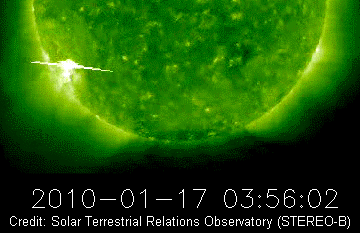
The eruption, which took place on the far side
of the sun, was invisible from EarthNevertheless,
NASA's STEREO-B spacecraft had a great view. STEREO-B
is stationed over the sun's eastern limb where it can
see things that we cannot. Solar rotation is slowly
turning sunspot 1039 back toward our planet and
STEREO-B will keep an eye on it as it approaches. Stay
tuned for updates
Current conditions
Solar wind
speed: 341.7 km/sec
density: 6.4 protons/cm3
explanation |
more data
Updated: Today
at 2345 UT
X-ray Solar Flares
6-hr max: C4
2035 UT Jan18
24-hr: C4
2035 UT Jan18
explanation |
more data
Updated: Today
at: 2340 UT
|
1-17-10 - sunspot 1040
Current conditions
Solar wind
speed: 334.7 km/sec
density: 10.0 protons/cm3
explanation |
more
data
Updated: Today at 2135
UT
X-ray Solar Flares
6-hr max: B5 2025
UT Jan17
24-hr: B5 2025 UT
Jan17
explanation |
more data
Updated: Today at: 2135
UT
RING OF FIRE:
Last Friday when the Moon passed in front of the sun, the
lunar diameter was a little too small to completely cover the
star behind it. The mismatch produced a lovely ring of fire:

"I took this picture from the shore of Weishan Lake in the
Shandong Province of China," says Xiang Zhan. "We had some
clouds, but fortunately the sun was able to shine through the
veil. The golden ring was very beautiful over
the frozen lake below."
The Moon was so small because it was near the far point of
its elliptical orbit around Earth. It was, in other words, an
"apogee Moon" about 10% too small for totality. The diminished
diameter did not, however, diminish the beauty of the event.
Browse the gallery for proof:
UPDATED:
Solar Eclipse Photo Gallery
[World
Map of Eclipse Sightings]

A BURST OF
NORTHERN LIGHTS: On Jan. 15th, a
burst of Northern Lights startled observers around
the Arctic Circle. "The sky exploded over my
head!" reports Øystein Lunde Ingvaldsen, who sends
this picture from Bø in Vesterålen, Norway:
"The Northern Lights were insane," he says. "To
record them, I used a
Nikon D300 set at ISO1600 (f/3.5) for a 10
second exposure."
Arctic photographers may wish to take note of
those settings, because more auroras are on the
way. A solar wind stream is heading toward Earth
and it could spark polar geomagnetic storms when
it arrives on Jan. 18th or 19th. Be alert for
auroras!
The display could intensify even more on Jan.
18th and 19th. That's when a solar wind stream
flowing from a coronal hole is expected to reach
Earth. High-latitude sky watchers should be
alert
for Northern Lights.
|
1-16-10 - sunspot 1040
Current conditions
Solar wind
speed: 356.1 km/sec
density:
more data
Updated: Today
at 2344 UT
X-ray Solar Flares
6-hr max: B2
1830 UT Jan16
24-hr: B3
1240 UT Jan16
explanation |
more data
Updated: Today
at: 2340 UT
ANNULAR SOLAR
ECLIPSE: Yesterday, the Moon passed in
front of the sun, producing a spectacular "ring
of fire" eclipse visible from the Indian Ocean and
surrounding lands. In Manila, James Kevin Ty caught
the eclipse in its partial phase:

"The low-hanging sun was dim and I didn't need any
special filter to photograph it using my
Canon 350D," says Ty. "In the foreground, a young
couple sat together in a boat enjoying the romantic
view."
Indeed, it was a lovely eclipse. Browse the
just-updated gallery for more examples:
|
| 1-15-10 - sunspot 1040
Current conditions
Solar wind
speed: 424.5 km/sec
density: 3.0 protons/cm3
explanation |
more data
Updated: Today
at 2345 UT
X-ray Solar Flares
6-hr max: B2
2110 UT Jan15
24-hr: C1
0840 UT Jan15
explanation |
more data
Updated: Today
at: 2340 UT
|
| 1-14-10 - sunspot 1040
WIDE SUNSPOT:
Sunspot 1040 has
grown so large (ten times wider than Earth) that only a
fraction of it fits on the page.

larger image:
http://www.spaceweather.com/swpod2010/13jan10/Dennis-Simmons1.jpg?PHPSESSID=pgrk2ev0ikfbpp3r1h3eteduc2
Dennis Simmons sends the image from Brisbane, Australia,
where a short spell of exceptionally steady air allowed him to
capture the sunspot with superb clarity. "After the software
had processed my data, I was left gasping, astonished by what
the seeing had allowed me to witness. This is far and away my
best-ever high-resolution image of a sunspot."
This sunspot is a fantastic target for backyard solar
telescopes. If you
have one, take a look!
more images:
from Francois Rouviere of Mougins, Alpes Maritimes,
France;
from Paul Haese of Blackwood, South Australia;
from Pavol Rapavy of Observatory Rimavska Sobota,
Slovakia;
from Paul Maxson of Surprise, Arizona;
from M. Jennings, K. Ritchie, J. Stetson of South
Portland, Maine
Current conditions
Solar wind
speed: 477.1 km/sec
density: 1.6 protons/cm3
explanation |
more
data
Updated: Today at 1226
UT
X-ray Solar Flares
6-hr max: B1 1005
UT Jan14
24-hr: B2 0120 UT
Jan14
explanation |
more data
Updated: Today at: 1220
UT
|
1-13-10 - sunspot 1040
Current conditions
Solar wind
speed: 513.1 km/sec
density: 1.7 protons/cm3
explanation |
more data
Updated: Today
at 2344 UT
X-ray Solar Flares
6-hr max: B1
1935 UT Jan13
24-hr: B2
1505 UT Jan13
explanation |
more data
Updated: Today
at: 2340 UT
2010 AL30 UPDATE:
An orbital analysis by Michael Khan of
the European Space Agency suggests
that 2010 AL30 could be the Fregat
upper stage of the Soyuz launch
vehicle that launched the Venus
Express probe in Nov. 2005:
full story.
ASTEROID FLYBY:
Is it an asteroid or a derelict
spacecraft? Mystery object
2010 AL30 is flew past Earth last
night only 1/3rd the distance to the
Moon, and telescopes around the world
were watching. In Colombia, amateur
astronomer Alberto Quijano Vodniza
used a 14-inch
Meade LX200 to record the close
approach:
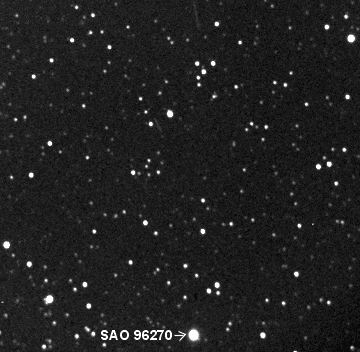
"2010 AL30 is the faint streak
moving among the stars," says Vodniza.
"The
full-length animation reveals a
second much brighter object. That's a
satellite that happened to be passing
by at the same time." Space is a busy
place, it seems.
Discovered barely three days
ago, 2010 AL30 is catalogued as a
10m-class asteroid. Curiously,
however, its elliptical orbit has a
period of almost exactly one year, the
same as Earth. This raises the
possibility that it might be a piece
of some spacecraft from our own
planet. NASA's Goldstone radar in the
Mojave desert was scheduled to ping
2010 AL30 between 2:20 and 4:40 UTC on
Jan. 13th. The echoes should reveal
the nature of this interesting
passerby.
|
| 1-12-10 - sunspot 1040
ACTIVE SUNSPOT:
Sunspot 1040 is
still growing. During the past two days it has
doubled in size--and then doubled again--to produce an
active region with more than 25 dark cores and a
tangled magnetic field. Dennis Simmons sends this
picture of the behemoth from Brisbane, Australia:
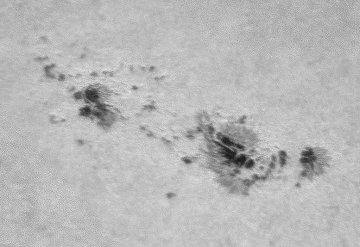
"Sweltering under the Australian
sun at over 31o C, I had to wipe the
perspiration from my eyes while attempting to obtain
sharp focus through Earth's shimmering atmosphere,"
says Simmons. "It didn’t help that I had my head under
a blanket to block out the bright sunlight that was
washing out the display on my Notebook computer! In
the end, technology and software allowed me to obtain
some reasonable results. It
is an impressive
sunspot."
Sunspot 1040 is a member of new
Solar Cycle 24, and its appearance continues a
recent trend of intensifying solar activity. NOAA
forecasters say there is a 15% chance of an isolated
M-class solar flare during the next 24 hours.
Readers with
solar telescopes should be alert for eruptions.
more images:
from Michael Wilk of Augsburg, Germany;
from Bob van Slooten of Amersfoort, Netherlands;
from Andy Yeung of Hong Kong
Current conditions
Solar wind
speed: 486.7 km/sec
density: 2.9 protons/cm3
explanation |
more
data
Updated: Today at 0435
UT
X-ray Solar Flares
6-hr max: B1 1815
UT Jan11
24-hr: B8 1355 UT
Jan11
explanation |
more data
Updated: Today at: 2355
UT
|
| 1-11-2010 sunspot 1040 sunspot 1040 - previously 1035\

Sunspot 1040 (a.k.a. old sunspot
1035) is a member of new Solar Cycle 24. Image credit: SOHO/MDI
ACTIVE SUNSPOT:
Sunspot 1040 is
busy growing again. In only 24 hours, it has expanded from
a barely visible "sun-speck" to a planet-sized active region
with 15 dark cores and a tangled magnetic field. Steve Riegel
sends this picture from his backyard observatory in Santa
Maria, California:

"On Sunday, the clouds opened up for some
fantastic viewing," says Riegel. "I photographed the active
region using a Lunt
60 solar telescope."
Sunspot 1040 is a member of new Solar Cycle
24, and its appearance continues a
recent trend of intensifying solar activity. NOAA
forecasters estimate a 10% chance of
M-class solar flares during the next 24 hours. Stay tuned.
more images:
from Mike Borman of Evansville, Indiana;
from James Kevin Ty of Manila, Philippines;
from Matt Wastell of Brisbane, Australia;
from Alcaria Rego of Almada, Portugal;
from Monty Leventhal OAM of Sydney, Australia;
from Karzaman Ahmad of Langkawi National Observatory,
Malaysia;
from Robert Arnold of Isle of Skye, Scotland;
from Paul Schneider of Wilton, Connecticut;
from J. Maciaszek, C. Cusack, J. Stetson of South
Portland, Maine;
from Gianfranco Meregalli of Milano, Italy;
from Javad Tasooji of Tehran, Iran;
from Brian Colville of Cambray, ON, Canada.
CURIOUS ASTEROID FLYBY: A curious object is about to fly past Earth
only one-third the distance to the Moon. Catalogued as a 10m-class
asteroid, 2010 AL30 has an orbital period of almost exactly 1 year. This
raises the possibility that it might not be a natural object, but rather a
piece of some spacecraft from our own planet. At closest approach on Jan.
13th, 2010 AL30 will streak through Orion, Taurus, and Pisces glowing like
a 14th magnitude star. Experienced amateur astronomers are encouraged to
monitor the flyby. Orbital elements, images, and more information are
available on http://spaceweather.com .
|
| 1-10-2010 -sunspot-1040
BIG SUNSPOT:
Sunspot 1040 (a.k.a. old sunspot 1035) is growing
again and is now at least four times wider than planet
Earth. A blink comparison of SOHO images shows how the
sunspot has expanded in the past 24 hours:

Backyard astronomers with
solar telescopes are encouraged to monitor
developments.
more images:
from Mike Borman of Evansville, Indiana;
from Matt Wastell of Brisbane, Australia;
from Alcaria Rego of Almada, Portugal;
from Monty Leventhal OAM of Sydney, Australia;
from Karzaman Ahmad of Langkawi National
Observatory, Malaysia;
from Robert Arnold of Isle of Skye, Scotland;
from Paul Schneider of Wilton, Connecticut;
from J. Maciaszek, C. Cusack, J. Stetson of South
Portland, Maine;
from Gianfranco Meregalli of Milano, Italy
Current conditions
Solar wind
speed: 298.0 km/sec
density: 1.9 protons/cm3
explanation |
more data
Updated: Today
at 2344 UT
X-ray Solar Flares
6-hr max: B2
2255 UT Jan10
24-hr: B4
0245 UT Jan10
explanation |
more data
Updated: Today
at: 2340 UT
|
1-9-2010 0 sunspot - 1040
Current conditions
Solar wind
speed: 271.4 km/sec
density: 2.0 protons/cm3
explanation |
more data
Updated: Today
at 2344 UT
X-ray Solar Flares
6-hr max: B5
2255 UT Jan09
24-hr: C1
1500 UT Jan09
explanation |
more data
Updated: Today
at: 2340 UT
SOLAR ACTIVITY:
Today has brought an uptick in solar
activity. Sunspot 1040 (a.k.a. old
sunspot 1035) is crackling with minor
solar flares and seems to be gathering
itself for something more. Just hours
ago, the Solar and Heliospheric
Observatory captured this
C1-class eruption:

Backyard astronomers
with
solar telescopes are encouraged to
monitor developments.
a movie:
"The plasma crawling around inside
AR1040 made me think of the head of
Medusa. It was exciting to watch!"
says amateur astronomer Michael Buxton
of Ocean Beach, California. "I made
this time-lapse movie at 1 minute
intervals from 2045-2215 UT on 8 Jan.
2010."
more images:
from Alcaria Rego of Almada,
Portugal;
from Brian Woosnam of North Wales,
UK;
from Emiel Veldhuis of Zwolle, the
Netherlands;
from Robert Arnold of Isle of
Skye, Scotland;
|
| 1-8-2010 - sunspot 1040 has appeared on the edge of the sun - it is
1035 gone all the way around the sun
SUNSPOT
RESURRECTED: Old and decaying sunspot
1035, declared to be "a corpse" just yesterday, is
showing signs of renewed life. Pete Lawrence sends
this picture from his backyard observatory in Selsey,
UK:

"A welcome view of the sun on a cold
January day reveals the remains of AR11035 still alive
and kicking," says Lawrence.
Beneath the waving filaments and
bright magnetic froth ("plage"), a dark core is
coelescing in the heart of the active region. That
makes it a genuine sunspot again. NOAA has re-numbered
the region "1040," but we will continue to refer to it
by its original name, "1035." It is, after all, an
old
friend.
more images:
from Emiel Veldhuis of Zwolle, the Netherlands;
from Robert Arnold of Isle of Skye, Scotland;
from Howard Eskildsen of Ocala, Florida;
from Fabio Mariuzza of Biauzzo - Italy

A
solar wind stream flowing from the indicated coronal
hole should reach Earth on Jan. 12th or 13th. Credit:
SOHO Extreme UV Telescope
COLD SUN:
You know its cold when the rising sun shines through
icicles ... in Florida. Mark Staples took this rare
photo overlooking Little Lake Santa Fe near Waldo, FL,
on Jan. 7th:
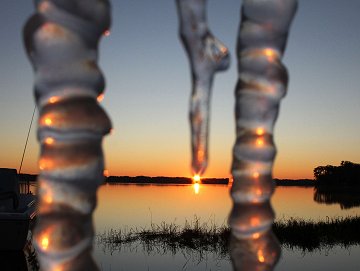
"The golden sunrise turned these
colorless spikes of ice into something resembling the
fiery trails we occasional see from here when NASA
launches a space shuttle," says Staples. "The warmth
of the sun quickly reduced these Florida-cicles, but
it was a rare a beautiful sight while it lasted."
This is, however, just the tip of the
icicle. The remarkable cold, which has struck not only
the United States, but also England and China, is
creating widespread displays of atmospheric optics.
The sun shining through ice in the air produces
sundogs, sun pillars, and a variety of luminous rings
and arcs. Browse the links below for examples.
more images:
from Evan Ludes of Omaha, Nebraska;
from Tyler Burg of Omaha, Nebraska;
from Dan
Bush of Albany, Missouri;
from Doug Zubenel of De Soto, Kansas;
from Julia Ponce of Papillion, Nebraska;
from Kyle George of Omaha, Nebraska
Current conditions
Solar wind
speed: 291.0 km/sec
density: 2.8 protons/cm3
explanation |
more data
Updated: Today
at 2346 UT
X-ray Solar Flares
6-hr max: B1
1745 UT Jan08
24-hr: B1
1745 UT Jan08
explanation |
more data
Updated: Today
at: 2340 UT
|
| 1-7-2010 sun is blank today
SUNSPOT CORPSE:
After a two-week trip around the farside of the sun,
sunspot 1035 has returned, but it not a sunspot
anymore. Where there was once a
dark-cored
behemoth crackling with solar flares, there is now
just a quiet splash of magnetic froth. Call it a
"sunspot corpse":
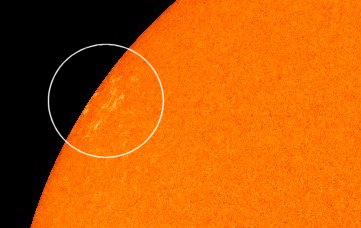
Image credit: Solar and Heliospheric
Observatory/MDI
Because corpses do not count, today's
sunspot number is zero. This is the first blank
(spotless) sun of 2010. So far this year, the sun has
been blank about 17% of the time--a sharp reversal
from the 71% rate of blank suns in 2009. Is solar
activity really increasing? If
recent trends continue, a new sunspot should
appear soon. Stay tuned.
more images:
from Howard Eskildsen of Ocala, Florida;
from Gianfranco Meregalli of Milano, Italy;
from C. Swiger and J. Stetson of South Portland,
Maine;
from Ron Cottrell of Oro Valley, Arizona
Current conditions
Solar wind
speed: 288.3 km/sec
density: 1.8 protons/cm3
explanation |
more data
Updated: Today
at 2346 UT
X-ray Solar Flares
6-hr max: B1
2125 UT Jan07
24-hr: B2
0350 UT Jan07
explanation |
more data
Updated: Today
at: 2340 UT
Why Won't the Supernova Explode?
January 7, 2010: A massive old star is about to die a
spectacular death. As its nuclear fuel runs out, it begins to collapse
under its own tremendous weight. The crushing pressure inside the star
skyrockets, triggering new nuclear reactions, setting the stage for a
terrifying blast. And then... nothing happens.
At
least that's what supercomputers have been telling astrophysicists for
decades. Many of the best computer models of supernova explosions fail
to produce an explosion. Instead, according to the simulations,
gravity wins the day and the star simply collapses.
Clearly,
physicists are missing something.
"We
don't really understand how supernovas of massive stars work yet,"
says Fiona Harrison, an astrophysicist at the California Institute of
Technology. The death of relatively small stars is better understood,
but for larger stars — those with more than about 9 times the mass of
our sun — the physics just doesn't add up.

A supercomputer model of a rapidly-spinning,
core-collapse supernova. NuSTAR observations of actual supernova
remnants will provide vital data for such models and help explain how
massive supernovas manage to explode. Credit: Fiona Harrison/Caltech.
[larger
image]
Something must be helping the outward push of radiation and other
pressures overcome the inward squeeze of gravity. To figure out what
that "something" is, scientists need to examine the inside of a real
supernova while it's exploding — not a particularly easy thing to do!
But that's
exactly what Harrison intends to do with a new space telescope she and
her colleagues are developing called the Nuclear Spectroscopic
Telescope Array, or NuSTAR.
After
it launches in 2011 aboard a Pegasus rocket, NuSTAR will give
scientists an unprecedented view of high-energy X-rays coming from
supernova remnants, black holes, blazars, and other extreme cosmic
phenomena. NuSTAR will be the first space telescope that can actually
focus these high-energy X-rays, producing images roughly 100 times
sharper than those possible with previous telescopes.
Using
NuSTAR, scientists will look for clues to conditions inside the
exploding star etched into the pattern of elements spread throughout
the nebula that remains after the star explodes.

Above: An artist's concept of NuSTAR. Focusing X-ray optics
require long focal lengths--hence the 10-meter deployable mast, which
is extended after launch. [larger
image] [more]
"You
don't get the opportunity to watch these explosions very often, ones
that are close enough to study in detail," Harrison says. "What we can
do is study the remnants. The composition and distribution of the
material in the remnants tells you a lot about the explosion."
One
element in particular is of keen interest: titanium-44. Creating this
isotope of titanium through nuclear fusion requires a certain
combination of energy, pressure, and raw materials. Inside the
collapsing star, that combination occurs at a depth that's very
special. Everything below that depth will succumb to gravity and
collapse inward to form a black hole. Everything above that depth will
be blown outward in the explosion. Titanium-44 is created right at the
cusp.
So the
pattern of how titanium-44 is spread throughout a nebula can reveal a
lot about what happened at that crucial threshold during the
explosion. And with that information, scientists might be able to
figure out what's wrong with their computer simulations.
NuSTAR will map the distribution of titanium-44 in
supernova remnants like this one, Cassiopeia A, to search for evidence
of asymmetries. Image Credit: Chandra X-ray Observatory. [more]

Some
scientists believe the computer models are too symmetrical. Until
recently, even with powerful supercomputers, scientists have only been
able to simulate a one-dimensional sliver of the star. Scientists just
assume that the rest of the star behaves similarly, making the
simulated implosion the same in all radial directions.
But
what if that assumption is wrong?
"Asymmetries could be the key," Harrison says. In an
asymmetrical collapse, outward forces could break through in some
places even if the crush of gravity is overpowering in others. Indeed,
more recent, two-dimensional simulations suggest that asymmetries
could help solve the mystery of the "non-exploding supernova."
If
NuSTAR finds that titanium-44 is spread unevenly, it would be evidence
that the explosions themselves were also asymmetrical, Harrison
explains.
To
detect titanium-44, NuSTAR needs to be able to focus very high energy
X-rays. Titanium-44 is radioactive, and when it decays it releases
gamma rays with an energy of 68 kilo-electronvolts (keV). Existing
X-ray space telescopes, such as NASA's Chandra X-Ray Observatory, can
only focus X-rays up to about 15 keV.
Normal
lenses can't focus X-rays at all. Glass bends X-rays only a miniscule
amount, so for a glass lens to bend X-rays enough to focus them, it
would have to be so thick that it would adsorb the X-rays instead.
X-ray
telescopes use an entirely different kind of lens. Called a Wolter-I
optic, it consists of many cylindrical shells, each one slightly
smaller and placed inside the last. The result looks a bit like the
layers of a cylindrical onion (if there were such a thing), with small
gaps between the layers.

Above: The x-ray "light path" of the EPIC camera of the XMM-Newton
satellite, a Wolter-I design similar to that used by NuSTAR. Credit:
ESA/ESTEC. [larger
image] [more]
Incoming X-rays pass between these layers, which guide the X-rays to
the focal surface. It's not a lens, strictly speaking, because the
X-rays reflect off the surfaces instead of passing through them the
way light passes through a glass lens. But the end result is the same.
NuSTAR's Wolter-I optic has a special atomic-precision coating that
enables its layers to reflect X-rays with energies as high as 79 keV.
Harrison and her colleagues have spent years perfecting the oles and blazars. NuSTAR will give us a new window
on the universe at its most extreme.
Author: Patrick Barry | Editor:
Dr. Tony Phillips | Credit:
Science@NASA
|
| 1-6-2010 sun is blank today
FIRST AURORAS OF 2010:
Last night, for the first time this year, the clouds parted over
Pangnirtung, an Inuit village on Baffin Island in the Canadian Arctic,
and the auroras came out to play:

"Mild temperatures at this time of year created a
heavy ice fog which blanketed the community, while the Northern Lights
danced over head," reports photographer
Claus Vogel. "A couple
of kids came over to investigate what I was doing, and within a few
minutes they were trying their hands at aurora photography. We even
played with the flashlight to write 2010."
The lights were sparked by a knot of
solar magnetism that wafted past Earth in the solar wind. The
south-pointing magnetic field from the sun partially cancelled the
north-pointing magnetic field of Earth. Solar wind poured through the
breach and fueled the display.
Says Vogel, "here's to more astronomical wonders in
the year ahead!"
NEW:
January Northern Lights Gallery
[previous Januarys:
2009,
2008,
2007,
2005,
2004,
2001]
SOLAR ACTIVITY:
Yesterday, January 5th, something exploded on the back side of the sun
and hurled a coronal mass ejection (CME) into space. Click on the SOHO
image to see the billion-ton cloud in motion:
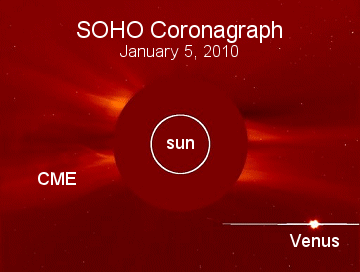
The source of the blast was probably one of several regions
currently located behind the sun's eastern limb. NASA's STEREO-B
spacecraft is monitoring three old sunspots there--AR1035, AR1036 and
AR1038. The emergent latitude of the CME best matches that of AR1036,
which will turn to face Earth in a few days.
more images:
from Howard Eskildsen of Ocala, Florida
Current conditions
Solar wind
speed: 322.3 km/sec
density: 3.7 protons/cm3
explanation |
more data
Updated: Today
at 2345 UT
X-ray Solar Flares
6-hr max: B5
1950 UT Jan06
24-hr: B5
1950 UT Jan06
explanation |
more data
Updated: Today
at: 2340 UT
|
| 1-5-2010 -sunspot 1039 EASY COME, EASY
GO: Sunspot 1039 is about to disappear
over the sun's western limb, but the sun won't remain
blank for long. Another active region is approaching
from the east, shown here in a Jan. 5th image from the
Solar and Heliospheric Observatory:

The approaching region is old sunspot 1035. It has
been transiting the far side of the sun since Dec.
20th. After all this time, is it still a
dark-cored
behemoth or just a decaying tangle of magnetic
fields? Monitoring is encouraged:
solar telescopes.
Current conditions
Solar wind
speed: 322.2 km/sec
density: 0.8 protons/cm3
explanation |
more data
Updated: Today
at 2343 UT
X-ray Solar Flares
6-hr max: A8
2235 UT Jan05
24-hr: B1
0850 UT Jan05
explanation |
more data
Updated: Today
at: 2340 UT
|
| 1-4-2010 - sunspot 1039
COMET TOAST:
The solar system has one less comet. The subtraction occurred
yesterday when a bright comet discovered by NASA's STEREO-A
spacecraft plunged toward the sun and evaporated. The Solar
and Heliospheric Observatory (SOHO) had an excellent view of
the encounter. Click on the image to set the scene in motion:
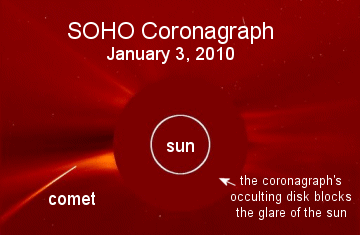
Latest movies:
gif,
mpeg-4,
m4v
One "dirty
snowball" went in; none came out. The doomed comet was a
member of the Kreutz sungrazer family. Named after a 19th
century German astronomer who studied them in detail, Kreutz
sungrazers are fragments from the breakup of a giant comet at
least 2000 years ago. Several of these fragments pass by the
sun and disintegrate every day. Most are too small to see but
occasionally a big fragment--like
this one--attracts attention.
Credit: The comet was found on Jan. 2nd by
Australian amateur astronomer Alan Watson, who was inspecting
images obtained by STEREO-A's Heliospheric Imager on Dec. 30,
2009.
Current conditions
Solar wind
speed: 307.6 km/sec
density: 3.4 protons/cm3
explanation |
more
data
Updated: Today at 0335
UT
X-ray Solar Flares
6-hr max: B1 2020
UT Jan04
24-hr: B7 0340 UT
Jan04
explanation |
more data
Updated: Today at: 2355
UT
|
| 1-3-2010 - sunspot 1039 DISINTEGRATING COMET:
A bright comet discovered by NASA's STEREO-A spacecraft is
swinging by the sun today and apparently disintegrating.


Latest
movies:
gif,
mpeg-4,
m4v
It will be interesting to see if a disembodied tail emerges
from behind the coronagraph's occulting disk in the hours
ahead.
This kamikaze comet is probably a member of the Kreutz
sungrazer family. Named after a 19th century German astronomer
who studied them in detail, Kreutz sungrazers are fragments
from the breakup of a giant comet at least 2000 years ago.
Several of these fragments pass by the sun and disintegrate
every day. Most are too small to see. Today's fragment is a
big exception.
Credit: The comet was found on Jan. 2nd by
Australian amateur astronomer Alan Watson, who was inspecting
images obtained by STEREO-A's Heliospheric Imager on Dec. 30,
2009.
Current conditions
Solar wind
speed: 293.7 km/sec
density: 5.1 protons/cm3
explanation |
more
data
Updated: Today at 1906
UT
X-ray Solar Flares
6-hr max: B6 1600
UT Jan03
24-hr: C1 0120 UT
Jan03
explanation |
more data
Updated: Today at: 1905
UT
|
1-2-2010 - sunspot 1039
SUNGRAZING COMET ALERT:
The Solar and Heliospheric Observatory (SOHO) is tracking a
comet that is about to make a perilous close approach to the
sun:
movie. Will the icy visitor survive? Click
here for the latest image. (Note: The comet was discovered
earlier today by Australian amateur astronomer Alan Watson in
images taken by NASA's STEREO-A spacecraft.)

Current conditions
Solar wind
speed: 274.5 km/sec
density: 2.5 protons/cm3
explanation |
more
data
Updated: Today at 1915
UT
X-ray Solar Flares
6-hr max: C2 1415
UT Jan02
24-hr: C2 1415 UT
Jan02
explanation |
more data
Updated: Today at: 1910
UT <
FIRST METEORS OF 2010:
The annual Quadrantid meteor shower peaks on Jan. 3rd around
1900 UT (2 pm EST) when Earth passes through a stream of
debris from shattered comet 2003 EH1. The timing of this
northern shower favors observers in Europe and Asia, who could
see as many as 100 meteors per hour during the brief but
intense display. In North America, where daylight will spoil
the show, it should be possible to hear the shower on meteor
radar. Tune into Space
Weather Radio for live echoes.
|
1-1-2010 - sunspot 1039


SNAP, CRACKLE, POP:
Sunspot 1039 is putting on a good show for amateur astronomers.
"The active region sizzled and popped as I photographed it on Dec. 31st,"
reports Michael Buxton of Ocean Beach, California.
"It is quite interesting to watch as energy
surges and swirls around the sunspot's dark cores," he says.
2010 appears to be picking up where 2009 left
off--with sunspot activity
on the rise. Readers with solar telescopes are encouraged
to monitor developments.
more images:
from Eric Roel of Valle de Bravo, México;
from Pete Lawrence of Selsey, West Sussex, UK;
from Matt Wastell of Brisbane, Australia;
from Michael Borman of Evansville, Indiana;
from Chris Schur of Payson, Arizona;
|
SPACE DATABASE ON THIS SITE
DREAMS OF THE GREAT EARTHCHANGES -
MAIN INDEX
|














































